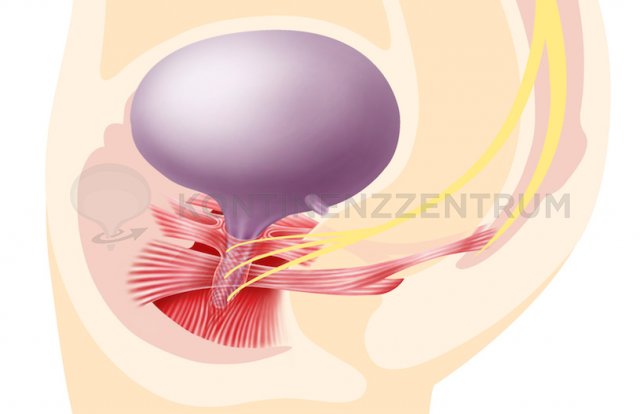Pelvic Floor Weakness
Insufficient Stability in the Pelvic Floor
The muscles of the pelvic floor enable a person to lift and carry objects without losing urine or stool. Even under strain, the pelvic floor is therefore able to hold back urine and stool so that it can be excreted later at the desired time. The pelvic floor thus acts as a downward closure of the pelvis and as support for the internal organs.
Pelvic floor weakness is the loosening and stretching of the supporting apparatus of the pelvic organs, particularly the female pelvic organs.
In the female pelvis, a number of organs are located in close proximity to each other and to the bladder: The bladder and urethra are located directly behind the pubic bone at the front, the uterus and vagina in the middle and the rectum at the back towards the sacrum. All these organs are connected to the pelvic bones and also to each other by muscles and ligaments.

Find Out More about Pelvic Floor Weakness
Do you suffer from pelvic floor weakness or suspect you may be developing bladder dysfunction? Find out now about your individual assessment and treatment options for a weak pelvic floor.
You can contact our Continence Centre in Hirslanden, Zurich, by telephone, email or via our contact form.
Symptoms of a Weak Pelvic Floor
A weak pelvis causes a whole series of complaints in those affected. The symptoms of a weak pelvic floor typically include:
- Pain in the abdomen
- Urge incontinence
- Stress incontinence
- Vaginal or uterine prolapse, in the worst case with the organs protruding from the vaginal entrance
- Fecal incontinence
- Bladder prolapse
- Rectal prolapse
- Lowering of the other bowel
To counteract symptoms such as incontinence, we have a wide range of treatment options at our disposal.

Who Is Mainly Affected by Pelvic Floor Weakness
Men, women and children can be affected by a weakening of the pelvic floor. Among adults, it often affects women. Statistically, around one in ten women suffer from pelvic floor weakness in the course of their lives, which is associated with a lowering of the pelvic organs - bowel, bladder and vagina.
In addition, men are also generally affected, especially after prostate or rectal surgery. Children can also suffer from a weak pelvic floor, especially in connection with neurological disorders.
Causes of Pelvic Floor Weakness

Pregnancy and childbirth affect the stability of the pelvic floor
The cause of pelvic floor weakness in women lies in the heavy strain placed on the connective tissue ligaments over the course of a woman's life, especially during pregnancy and childbirth. During pregnancy, the uterus increases significantly in size and weight, putting a great deal of strain and stretching on its ligaments. There is a real risk of one or more ligaments tearing.
The muscles and ligaments holding the bladder, vagina and uterus can also be loosened or even torn during childbirth, leading to pelvic floor weakness. In women with weak connective tissue, however, even without childbirth, everyday strain over the decades can lead to loosening and stretching of the supporting apparatus and thus to bladder prolapse.
After the menopause, a prolapse of the bladder, uterus or rectum can become noticeable, possibly due to hormonal factors and weight gain.
In men, prostate surgery (often after complete removal for prostate cancer, less frequently after surgery for benign enlargement of the prostate) can lead to weakness of the pelvic floor, especially the urethral sphincter. The reason for this is an injury to nerve pathways leading to the pelvic floor.
How Our Treatment Counteracts Pelvic Floor Weakness
Depending on the severity of the symptoms, we have various options for treating pelvic floor weakness. The treatment spectrum ranges from targeted physiotherapy and drug therapy to surgical methods such as DaVinci surgery.
With us, you can perform specific exercises aimed at strengthening the pelvic floor muscles. Our pelvic floor therapy focuses on sustainability:
- In step one of pelvic floor training - carried out under supervision - learn how to specifically target the muscles of the pelvic floor.
- Increase both the strength and endurance of your pelvic floor muscles with pelvic floor exercises. The whole thing works for different positions of the body.
- The training learned in pelvic floor therapy can be repeated at home. We will draw up a training plan tailored to your needs.
- If a patient cannot tense the pelvic floor herself or can only control it insufficiently, we use an electronic probe to demonstrate to the patient what tensing and relaxing the pelvic floor feels like.
- The muscles of the pelvic floor can also be stimulated and built up using transcutaneous electrical nerve stimulation (TENS). We tailor the corresponding training plans to your individual needs. For many patients, this functional stimulation of the pelvic floor is the ideal complement to traditional pelvic floor training, making them fit for everyday life.
- With biofeedback, we also have an imaging procedure at our disposal that visualizes training progress as well as the need for correction during exercises.

Biofeedback is an efficient addition to classic pelvic floor training
In some severe cases, conservative treatments may not be able to sufficiently alleviate or resolve the symptoms. Various surgical procedures can then be used. The surgeon decides which procedure to use depending on the location of the organs. While in some cases of prolapse the anterior or posterior vaginal wall can be tightened or attached to the uterus in the pelvis, in other cases it makes sense to perform an abdominal incision. Depending on the severity of the prolapse, the robot-assisted DaVinci operation can be performed. In this procedure, the surgeon controls the arm of a robot inside the patient's body via a control console, so that very exact and precise actions are possible. The Da Vinci surgical system combines the advantages of minimally invasive surgery with "high-definition" 3D visualization techniques and has serious advantages for both the patient and the surgeon, so that it is now used worldwide and has long been a reality.
Which Areas of Life Are Affected by a Weak Pelvic Floor
Obesity, chronic physical overload, poor posture, pelvic surgery and sometimes medication can weaken the pelvic floor in women and men.
Pelvic floor-related complaints have a considerable impact on everyday life and reduce the quality of life in various areas. This also includes sex life. In a fully healthy person, the pelvic floor is in a relaxation phase:
- Excretion of urine
- Bowel movement
- Sexual intercourse (woman)
- Erection (man)
When reaching a sexual climax, on the other hand, the pelvic floor pulsates, which means that contraction and relaxation alternate in rapid succession. However, a weak pelvic floor restricts this and therefore reduces the sensation of pleasure, which can be a strain on a partnership.
Expertise for You in All Aspects of Pelvic Floor Weakness
In the urogynaecology department of Continence Center Hirslanden, pelvic floor training is carried out under the guidance of experienced pelvic floor therapists, so that we can effectively treat conditions such as pelvic floor prolapse. You are in the best and most competent hands with us, from the initial diagnosis and consultation to overcoming the ailment.
Contact us for a consultation and we will be happy to inform you about your individual assessment and treatment options. You are welcome to use our online appointment system or contact us by telephone.
